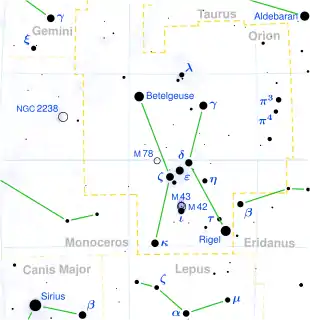Pi1 Orionis
Pi1 Orionis (π1 Ori, π1 Orionis) is a star in the equatorial constellation of Orion. It is faintly visible to the naked eye with an apparent visual magnitude of 4.74.[2] Based upon an annual parallax shift of 28.04 mas,[1] it is located about 116 light years from the Sun.
 | |
| Observation data Epoch J2000.0 Equinox J2000.0 (ICRS) | |
|---|---|
| Constellation | Orion |
| Right ascension | 04h 54m 53.72877s[1] |
| Declination | +10° 09′ 02.9952″[1] |
| Apparent magnitude (V) | 4.74[2] |
| Characteristics | |
| Spectral type | A3 Va[3] |
| U−B color index | +0.09[2] |
| B−V color index | +0.08[2] |
| Astrometry | |
| Proper motion (μ) | RA: +41.49[1] mas/yr Dec.: −128.73[1] mas/yr |
| Parallax (π) | 28.04 ± 0.25[1] mas |
| Distance | 116 ± 1 ly (35.7 ± 0.3 pc) |
| Absolute magnitude (MV) | 1.76±0.08[4] |
| Details | |
| Mass | 1.97±0.07[4] M☉ |
| Radius | 1.67[5] R☉ |
| Luminosity | 16.6[5] L☉ |
| Surface gravity (log g) | 4.15[3] cgs |
| Temperature | 8,611[3] K |
| Metallicity [Fe/H] | −1.24[3] dex |
| Rotational velocity (v sin i) | 120[6] km/s |
| Age | 100[5] Myr |
| Other designations | |
| Database references | |
| SIMBAD | data |
This is an A-type main sequence star with a stellar classification of A3 Va.[3] It is a Lambda Boötis star,[8] which means the spectrum shows lower than expected abundances for heavier elements.[9] Pi1 Orionis is a relatively young star, just 100 million years old,[5] and is spinning fairly rapidly with a projected rotational velocity of 120 km/s.[6] It has nearly double[4] the mass of the sun and 167% of the Sun's radius. The star radiates 16.6[5] times the solar luminosity from its outer atmosphere at an effective temperature of 8,611 K.[3]
An infrared excess indicates there is a debris disk with a temperature of 80 K orbiting 49 AU from the star. The dust has a combined mass 2.2% that of the Earth.[5]
References
- van Leeuwen, F. (2007), "Validation of the new Hipparcos reduction", Astronomy and Astrophysics, 474 (2): 653–664, arXiv:0708.1752, Bibcode:2007A&A...474..653V, doi:10.1051/0004-6361:20078357, S2CID 18759600.
- Mermilliod, J.-C. (1986), "Compilation of Eggen's UBV data, transformed to UBV (unpublished)", Catalogue of Eggen's UBV Data, SIMBAD, Bibcode:1986EgUBV........0M.
- Gray, R. O.; et al. (July 2006), "Contributions to the Nearby Stars (NStars) Project: spectroscopy of stars earlier than M0 within 40 pc-The Southern Sample", The Astronomical Journal, 132 (1): 161–170, arXiv:astro-ph/0603770, Bibcode:2006AJ....132..161G, doi:10.1086/504637, S2CID 119476992.
- Gerbaldi, M.; et al. (June 1999), "Search for reference A0 dwarf stars: Masses and luminosities revisited with HIPPARCOS parallaxes", Astronomy and Astrophysics Supplement, 137 (2): 273–292, Bibcode:1999A&AS..137..273G, doi:10.1051/aas:1999248.
- Rhee, Joseph H.; et al. (May 2007), "Characterization of Dusty Debris Disks: The IRAS and Hipparcos Catalogs", The Astrophysical Journal, 660 (2): 1556–1571, arXiv:astro-ph/0609555, Bibcode:2007ApJ...660.1556R, doi:10.1086/509912, S2CID 11879505.
- Royer, F.; et al. (February 2007), "Rotational velocities of A-type stars. III. Velocity distributions", Astronomy and Astrophysics, 463 (2): 671–682, arXiv:astro-ph/0610785, Bibcode:2007A&A...463..671R, doi:10.1051/0004-6361:20065224, S2CID 18475298.
- "* pi.01 Ori". SIMBAD. Centre de données astronomiques de Strasbourg. Retrieved 2016-11-15.
- Gray, R. O.; Corbally, C. J. (August 1993), "A search for Lambda Bootis stars in OB associations", Astronomical Journal, 106 (2): 632–636, Bibcode:1993AJ....106..632G, doi:10.1086/116668.
- Kamp, I.; et al. (April 2008), "λ Bootis stars: Current status and new insights from Spitzer", Contributions of the Astronomical Observatory Skalnaté Pleso, 38 (2): 147–156, Bibcode:2008CoSka..38..147K.
